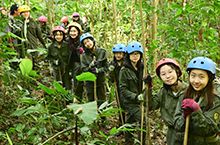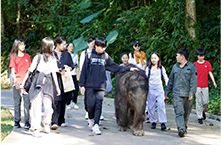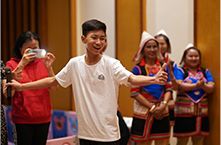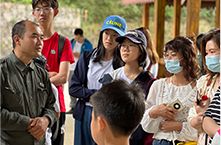Xishuangbanna fieldwork
Tropical Rainforest
Xishuangbanna used to be the best preserved tropical ecosystem in China. However, the extraordinary tropical rainforest is endur ing negative impact from economic activitles. For the past few docades, rubber planting has spread like a wildfire in Xishuangbanna for economic gains. Rainforest were cut down, and thousands of ancient tropical plants were replaced by rubber fields and banana groves. In order to restore sustainable development of the local ecosystem, we need to implement socially responsible yet economically stimulating initiatives to support Xishuangbanna residents while maintaining biodiversity.




Asian Elephants
In April 2021, a herd of wild Asian elephants migrated north from Xishuangbanna. This unusual path concerned the world. Millions of people were discussing this topic from around the world: where have the elephants gone?
In China, there are only 300 Asian elephants in the wild. Their habitat area has shrunk from 2,084 square kilometers in 1976 to less than 500 square kilometers in the past years. The Asian Elephants that can't get enough food in the rain forests could only walk step by step towards the edge of the forest, to the farmlands and human villages in search of food, which signifcanty in creased the risk of potential conflicts between humans and elephants. These beautiful creatures are in desperate need of sustainable food resource, healthy habitats, and a safe environment for their offspring. The Elephant Future Public Foundation has been at the forefront of elephant protection in Xishuangbanna through field study and documentary filming, however, continuous monitoring and intervention are needed to prevent further escalations between humans and elephants.


Jino Ethnic Culture
Jino People, one of the 56th ethnic groups in China, pride themselves with their unique cultural heritage. Jino's charactoristic dance, Daiguan, is one of the first designated national intangible cultural heritage. Jino's clothing style employs a unique craft of textile and machete cloth with a rich lineage, fascinating local communities and beyond. The distinctive Jino costumes, architec tures, rituals, and customs, formed the unparalleled culture of Jino. However, as more and more young people leave their homeland to seek opportunities in metropolitan areas, Jino culture is now gradually disappearing and continuously being assimilated into the mainstream narratives. It is our hope that through education, advocacy, and artistry, Jinos will maintain their deserved rocognition in the modern world.



PARTNERS
Xiyan Zhang-Vice Prasident, Secretary Genral of Xishuangbanna Trapical Rainforest Foundation

EVENTS
To protect the disappearing beauties, many stakeholders have delivered collaborative efforts in Xishuangbanna. These activities not only allowed us to see the actual situation of the Jino people, rainforest and wildlife protection, but also deepened our understanding of sustainable development.
1. On-site Investigation of Xishuangbanna Tropical Rainforest
- Explore the rainforest during different seasons
- Participate in the Tropical Rainforest Restoration Project
- Research endangored plants
- Meet the last Jino hunter-following his lead, students attained first-hand experience to grow more
empathy and curiosity towards nature
2. Befriend the Asian elephants
- visit the Asian Elephant Breeding and Rescuo Center
- Listen to lectures from experts and conduct Interviows with them
- Participate in the Young Elophant Future Growth Program
- Interact with baby elephants, learn about their stories and share with the public
3. In-depth Exposure to Unique Exhibitions
- Develop a deeper knowledge of Jino ethnicity and culture at the Jino museum
- Participate in Jino intangible cultural heritage protection projects
4. Participate in Local Festivities
- Interview and document local residents'narrative of festivals and rituals
- Join in the preparation for important festivals
5. Collaborate with Local Youth
- Discuss and explore possibilities of sustainable development with the local young
people
- Construct meaningful and beneficial communication




